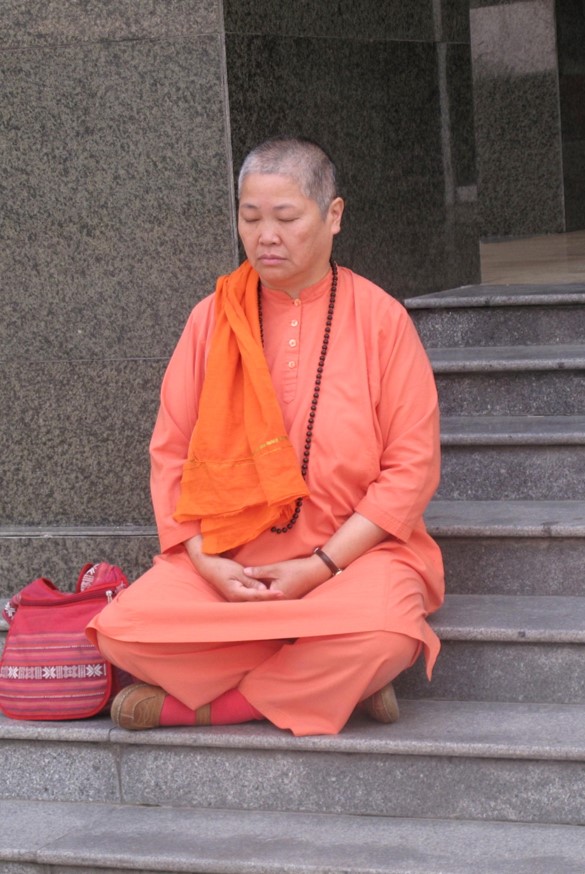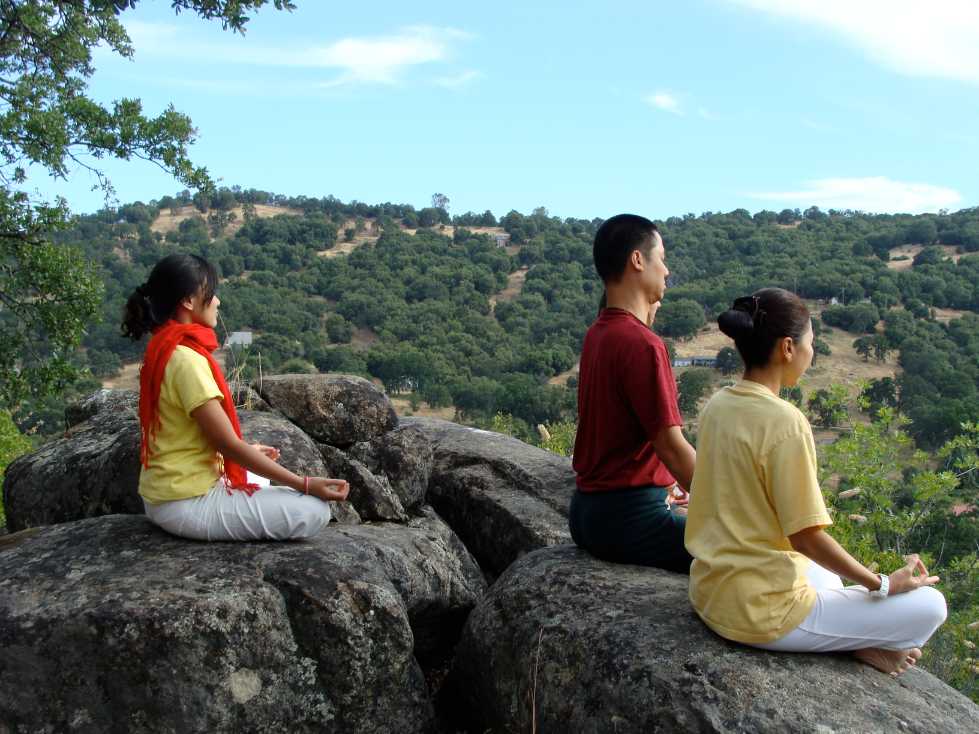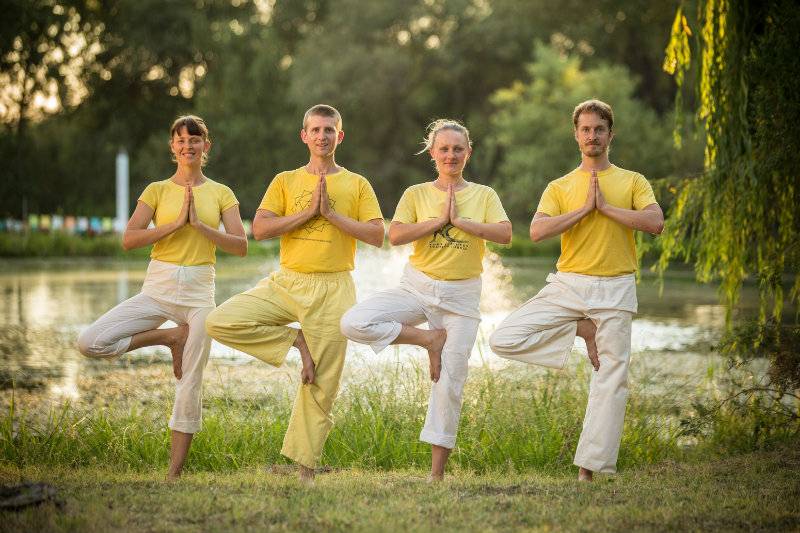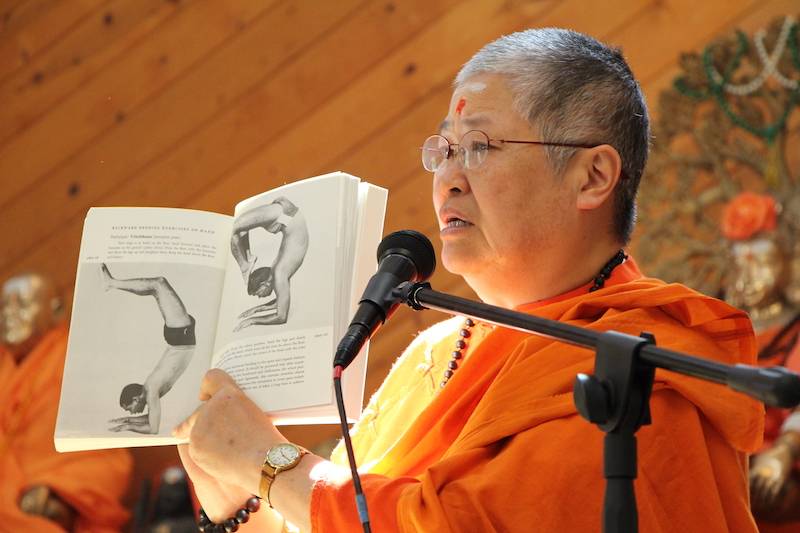What is Yoga Meditation?
by Swami Sitaramananda
I’m so surprised to know that more and more people are understanding that yoga is meditation and meditation is yoga. Now people become more educated, and know that yoga is not just only exercise. With this kind of exercise, or yoga exercise and yoga asanas, are actually leading you to meditation, because it is accompanied by breathing.
Conscious breathing and also conscious relaxation. So conscious breathing, conscious concentration, conscious relaxation, and a steady pose will bring you to the state of meditation.
What yoga meditation is and what it is not
- Meditation is a process, resulting from a successful turning inwards of the mind and a conviction that there is a truth higher and more satisfying than what the mind and our intelligence can come up with. Usually people have to come to a dead-end in their search for happiness and solutions in the mental and sensual realm to start meditation seriously.
- Meditation is not separated from life. It can not be expected to work right away. It is a culmination of a purified and sattvic life. Best is to let go of all expectations and to keep oneself open and steady in the meditation practice.
- Attempts to withdraw the senses and to calm down the mind often lead to meditation. These are the 4th and 5th steps on the ladder of Raja Yoga. Meditation is the 7th If you can not meditate yet, attempt to stay quiet, withdraw the senses and concentrate the mind. This is already very helpful.
- Asanas and pranayama practice are the 3rd and 4th steps towards meditation. Stabilized meditative postures and regulation of the breath help tremendously in calming the mind down.
- Meditation requires lots of prana and mental concentration. Regulating of lifestyle is helpful to conserve prana for the inner search and realization. This article goes in detail about How to Use our Prana Energy.
- A sick person with low prana has more difficulty to gather the rays of the mind and have enough prana to meditate. Resting in prayers at that time is helpful.
- A habitual practice of japa, repetition of mantras, keeps the mind fit for meditation. Mantras give prana to the mind and bring one directly in connection to pure transcendental energy .
- Success in meditation is seen in mental strength and calmness in daily life, not in experiencing fantastic psychic phenomena.
- Important realization: Depending on the guna and the person, meditation can lead the person to devotion to the Supreme, in whatever form or name, also the faith or conviction that there is a Truth or Light beyond one’s darkness or confusion. Help the meditator to Connect wholeheartedly with the secure and fulfilled divine love. Bhakti Yoga is helpful to channel emotional energy and bring acceptance, humility and an attitude of self surrender necessary to balance out the mental concentration and will of a meditator. Meditation cannot be just a technique, separated from love and devotion.
- Also Meditation is not ungrounded imagination, seeing things, flying up in the air, astral travelling, going through walls, reading people ‘s thoughts. The only goal of meditation is to achieve mental peace and balance.
- Meditation is not opening oneself to all subtle influences.
- Meditation is not building castles in the air, meditation is not drifting in a dream state.
- Meditation is not expectation of any kind.
- Meditation is not “spacing out” and abandoning one’s responsibilities. This article goes into detail about Yogic Guidelines for Good Conduct.
- Meditation is not escaping into an inner world, disconnecting with others and isolating oneself. This is very important point, as people resort to meditation to escape from pain in the duality world of imperfections without actually doing anything to bring back balance and purity to the mind. Therefore meditation needs to come with service to others, forgiving others and oneself and opening one’s heart to love and compassion. Meditation comes easier with karma yoga.
- Meditation is not relinquishing one’s intelligence. It is consciously using intelligence to know the difference between illusions and reality and eventually going beyond the limited intelligence to tap into the intuitive source of knowledge.
- Meditation can not come with fears or desires. Courage and faith are needed to face and experience the unknown and tread new territories of the mind. This article talks about Transforming Fear into Courage and Faith.
- The mind needs to be healthy and strong to meditate. A disturbed, neurotic and fearful mind should not meditate. It is better to resort to asanas and pranayama and to therapeutic counselling to overcome the negative tendencies of the mind, before attempting serious meditation. Regularly sitting quietly, trying to calm the mind down, is already helpful.
- Self-enquiry and self-awareness, the regular habit of observing one’s thoughts are stepping stones in the process of meditation.
- One can not meditate if one is not attempting to separate oneself from the mind. Knowing that the mind is not the Self, and detaching from the mind’s activities is already a big step in meditation. Small daily conquests to control the lower mind and exercise the higher mind are already big steps.
- Self-awareness is a stepping stone to meditation, which is the step of merging with the background, the consciousness within. Self-awareness starts with the purification of thoughts (learning to think correctly or nourishing sattvic thoughts and sattvic diet) and diminishing of mental activity (which means increasing the concentration on the divine). This article talks about what is Self-Awareness and Intuition.
- The Self is always there, it is the mental turbulences that prevent us from seeing the Self.


Meditation techniques protocol
- Meditation techniques are simple. Instructions need to be clear and simple. Not too many words or leading people into an imagination journey.
- Daily 10-15 minutes meditation is a good start. Increase to half hour daily, twice a day.
- Place: clean, quiet, airy.
- Time: early 4-6am or 6-8pm or first thing when wake up.
- Posture: cross legged, comfortable with back and neck straight. Use props or pillows to elevate buttocks to help keep the spine straight. People unable to sit cross legged on the floor can sit on a chair either with both feet firmly on the ground, or crossing the feet. Hands are on the knees, thumb and index fingers touching in “chin mudra”, palms turning upwards or on the knees downwards, arms slightly bent or straight. Better not to lean on back of chair or against a wall. Sit independently. Eyes closed. Command the body to be still and relax, turning inwards for a specific length of time.
- Breath : 3 kinds. First, three long inhalations to bring more oxygen to the brain and three long exhalations to completely relax and let go of the day. If more stress, then exhalation longer than inhalation. Next is regulating the breath to the count of 3 – om 1 – om 2 – om 3. Inhalation and exhalation are same length. This will help the regulation of prana and of thought. Then as you sit still, the breath automatically will slow down even further to an imperceptible rhythm, where the breath hardly comes out of the nostrils and one feels very comfortable. This is when the mind leaves the physical external reality to settle in the inner state of meditation
- Point of focus: Either the point between eyebrows or point at middle of chest. These are subtle high energy centers. To find one’s point of focus, one needs to follow one’s habits. Either point leads to same place. Because the focus of the prana will lead the prana into entering into the sushumna, and the moving upwards of energy through different levels of consciousness and realization. It is not remaining in the dual state of being emotional or being intellectual. We do not focus at lower chakras.
- Object of focus: The mantra om is the universal sound of unity and of creation. It can be used by all. If the student wants to use a personal mantra, the teacher needs to guide him/her to find the ishta devata, then the mantra will correspond to the ishta. It is a rigorous practice of concentration on mantra exclusively to bring about one-pointedness of mind. The devotion helps the concentration. The mental repetition of a mantra needs to be coordinated with the breath. The mantra should be part of the breath. Mental repetition is stronger than verbal repetition.
- The practice: if the mind wanders, step back (or detach) from the thought and gently bring it back to focus, i.e. to the breath and the mantra. If confused between breath and mantra, focus on the mantra. After sometime, the mind will become still and the mind enters deeply within. One feels lighter and more expanded. At any point in time, do not force the process, rather surrender to the process.
- Eventually thoughts become pure, seem to be devoid of meaning, however it just means that the mind is thinning out and the ego has lost its grasp over the mind. Keep the process going without expectation.
- Come out of meditation after the fixed period of time. Do not try to go beyond limits as the mind will revolt and will kick back. Better to leave some interest in the mind and start over again with zeal and enthusiasm the next session. Continue to purify the mind in daily life. The more the mind is pure, the more the process of meditation is easier and faster.
- The words used to describe the meditation are: the meditator, the object of meditation and the process of meditation become one. The thinker, the thought and the process of thinking become one. The lover, the beloved and the love become one.
- The meditator guiding meditation to a group needs to have the meditative integrated experience him or herself. The voice tone needs to be warm, neutral, the instructions are clear, facilitating focus and calmness, inducing the internalized journey. In the voice, the prana is transmitted. Less words and precise words are better.

Benefits of yoga meditation
It is important to remind the beginners/meditators of the benefits of meditation so they can keep the practice going. It is better to be conservative to start slowly, regularity of practice is more important. Increase the length of meditation proportionately to the purification and calmness of the mind. Watch the diet and the activities/ lifestyle. Increasing Sattwa is the key.
- Meditation helps to bring one to the here and now.
- Meditation helps to alleviate the subconscious from its loads of impressions of the past, samskaras, addictions and habits.
- Meditation will bring self-awareness, develop the consciousness and discriminative intelligence .
- Meditation will develop intuitive faculties, the inner knowing and sensing of what is right and wrong.
- Meditation brings clarity to the mind.
- Meditation calms the emotions and opens the heart to forgiveness and love. Meditation heals relationships. Meditation is connecting wholeheartedly with the secure and fulfilled divine love.
- Meditation brings one in touch with the true, perfect and secure Self, the consciousness within and thus releases stress, anxieties and recharges one’s self with new faith and love.
- Meditation lowers heart rates, improves the immune system, heals the body and mind.
- Meditation rejuvenates
Questions on Yoga meditation
- Describe the techniques of meditation.
- What should be prescribed if a person can not meditate or sit still?
- How can you distinguish between escaping from reality, and clearing out the mind from past samskaras and realizing the Self? What can you do to improve the process and achieve balance?
- What are three things achieved during meditation?
- Why is courage an important virtue in meditation?
Follow us
[et_social_follow icon_style=”slide” icon_shape=”rounded” icons_location=”top” col_number=”2″ counts=”true” counts_num=”0″ outer_color=”dark”]




